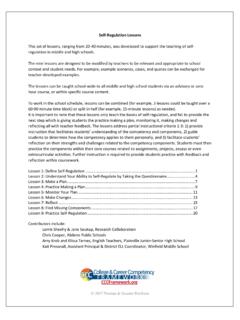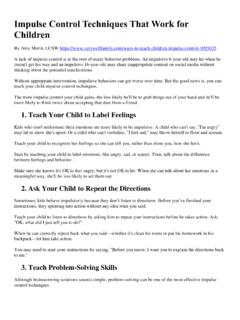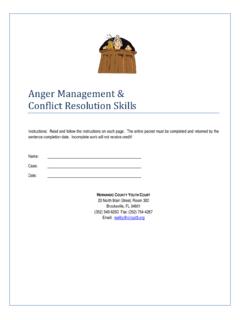Transcription of Classroom Management Strategies for Effective Instruction
1 Classroom Management Strategies for Effective InstructionPresenter: J. LovejoyRegion One ESCW orkshop #595461 Goals and identify the characteristics of Effective assist teachers in taking a look at their own Classroom Management identify techniques for organizing and managing Effective learning Definition: The capacity to reflect on actions, to weigh choices, to make sensible judgements, and to act behavior requires requires Proactive Classroom Management a productive positive relationships with all students in the greetings at the door to pre-correct and establish a positive rules/expectations and procedures are visible and known by every are managed seatwork is managed and used when competently w/ , model, and reinforce prosocial system to reward desirable setting and performance schedule of Classroom cuing systems to release and regain to 1 ratio of positive.
2 Negative and being numerous opportunities to respond Classroom Management of the things that a teacher does to organizestudents, space, time and materialsso that Instruction in content and student learning can take major foster student involvement and cooperation in all Classroom establish a productive working Days of School, WongDownloaded from of a well-managed classroom6 of a Well-Managed Students are deeply involved with their work Students know what is expected of them and are generally successful There is relatively little wasted time, confusion, or disruption The climate of the Classroom is work-oriented, but relaxed and well-managed Classroom A task oriented environment A predictableenvironment Is readyand waitingfor students8 Building a Consistent Management Framework from School Improvement Network: Instruction10 Intervention and RedirectionEngaging InstructionRelationships and SupportClear ProceduresVision and High Expectations Together these components contribute to an environment in which all students can succeed.
3 School Improvement NetworkPutting systems in place that empower students to be successful!Brainstorming of as many responses to the following statement as you Effective teacher : Use the envelopes provided and make two columns on your table with headings of Effective Teacher and A Dangerous Educator . Place the statements under the appropriate Dangerous Believes that this job is not about relationships Believes that this is just a job, and when the school day is over, the work s all done. Believes that he/she can handle any situation, alone. Believes that, It was good enough for me, by golly, it oughta be good enough for them. Believes that all these kids need is a good whippin.
4 12A Dangerous Believes that what he/she does outside of here has no bearing Believes that anger shouldn't be part of the curriculum Never makes time to just sit and listen Believes that this kids have no right to be mad Believes that he/she can t make a difference Believes that punishment is more Effective than discipline13A Dangerous Thinks you shouldn t smile until Thanksgiving. Believes that morality and values should only be taught at home Sees the act, not the young person behind it. Believes that strict adherence to the rules is the most important goal of any child s day. Forgets he/she is modeling. Is a structure monster .-Malcolm Smith14 The Effective Establishes good control of the Classroom Does things right, consistently Affects and touches lives Exhibits positive expectations for ALL students Establishes good Classroom Management techniques15 The Effective Designs lessons for student mastery Works cooperatively and learns from colleagues Seeks out a mentor who serves as a role model Goes to professional meetings to learn Has a goal of striving for excellence16 The Effective Can explain the district s, school s, and department or grade level s curriculum Realizes that teaching is not a private practice Is flexible and adaptable Listens, listens.
5 Listens Understands the research process17 The Effective Teaches with proven research-based practices Knows the difference between an Effective teacher and an ineffective one18In Effective Has positive expectations for student success Is an extremely good Classroom manager Knows how to design lessons for student mastery 19 Understanding Our StudentsDealing With Student Behavior in Today s Classrooms20 This is not an easy time to work with children and One in six youths (age 10-17) has seen or knows someone who has been shot (Children s Defense Fund) At least 160,000 students skip class each day because they fear physical harm (NEA) In the last 10 years, the likelihood that a child under 18 will be killed by guns rose almost 250% (FBI Uniform Crime Reports)*21 Every school day, 6,250 teachers are threatened with bodily injury (NEA) More than 150,000 school age children bring a gun to school each school day (Children s Defense Fund) More than 50% of children in the fear violent crime against themselves or a family member (Newsweek)*22 Every 10 seconds a crime occurs in a school (Children s Defense Fund) 70% of those arrested for hate crimes are under age 19 ( News)
6 *23We can trace out-of-control behaviors to a variety of The physical and emotionalclimate of the child's home and neighborhood The amount of stabilityand consistency in the child s family The parenting styles of the child s parents The powerand influence of peers in a child s life*24We can trace out-of-control behaviors to a variety of the positiveand negativerole models available to the child The child s exposure to violentmedia The child s emotionaland physicalhealth The child s own attitude toward his/her anger*2526In the last two decades, there has been a 200% growth in single parent households ( Bureau of the Census)The Changing FamilyThe number of moms leaving home for work each morning has risen 65% in the past 20 years ( Bureau of Labor Statistics)Nearly 1 in 4 children in the are living below the poverty level (Children's Defense Fund)*27 More than half of all American children will witness their parent s divorce ( Bureau of the Census)In the last 10 years, the estimated number of child abuse victims has risen by nearly 50% (National Committee for the Prevention of Child Abuse)The average child has watched 8,000 televised murders and 100,000 acts of violence before finishing elementary school (American Psychological Association)*Why kids Misbehave Basic has several Functions.
7 Attention from peers or adults Attain power/control Revenge or Retaliation Feels Good/Play Fear of Failure Getting something (Sensory Input) Imitation28 Proactive Intervention Strategies Classroom Rules Classroom Schedule Physical Space Attention Signal Beginning and Ending Routines Student Work Classroom Management Plan adapted from the Tough Kid series, and CHAMPs29 Classroom from Rules for Rules: Keep the number to a minimum (approx. 5). Keep the wording simple. Have rules represent you basic expectations Keep the wording positive, if possible. Make your rules specific. Make your rules describe behavior that is Rules, cont. Make your rules describe behavior that is measurable.
8 Assign consequences to breaking the rules. Always include a compliance rule . Keep the rules posted. Consider having rules recited daily for first two weeks then Inappropriate Rules: Be responsible Pay attention Do your best Be kind to others Respect authority Be polite Preferred Rules: Keep hands, feet, and objects to yourself. Raise your hand and wait for permission to speak. Sit in your seat unless you have permission to leave it. Walk, don t run, at all times in the The best consequences are reasonable and logical A reasonable consequence is one that follows logicallyfrom the behavior rather than one that is arbitrarily imposed The best logical consequences teachthe students to choose between acceptable and unacceptable Corrective Consequences Proximity Management Verbal reprimand/Warning Time owed after class In-class time-out Parental contact Restitution Principal Notification Form Disciplinary ReferralIt should be noted that prior to enacting corrective consequences, positive reinforcement Strategies should be utilized.
9 For the following types of student behavior, develop both an example of a logical consequence AND an illogical Chews gum Turns in sloppy paper Walks in the Classroom noisily Passes paper in incorrectly Arrives late Does not bring textbook Does not bring pencil or pen37 Use chart paper to record your Techniques Provide enough space, variety of materials. Establish consistent, balanced routine. Support children s choices, interests. Plan for transitions. Keep waiting periods short, One ESC 200638 Problem-Prevention Techniques Respect behavioral differences. Respect children s ideas, concerns, feelings. Set reasonable limits & expectations. Stop destructive/aggressive behavior.
10 Use observations in daily One ESC 200639 TurtleRegion One ESC 200640 Avoids the problem or mentions it but doesn t follow through. Don t you think you might need a sweater? Don t you think that you might break the stapler? I hope you don t hurt each other .SharkRegion One ESC 200641 Jumps right in and solves children s problems for them. Tends to be directive and critical. Blames children for their actions. Provides too much structure with no room for child input. I can t believe you re going outside without a sweater! Go get your sweater on NOW! That s it with the stapler. I m putting it away until you can learn to use it properly. Jenny, give that block to Tara. She had it first.














